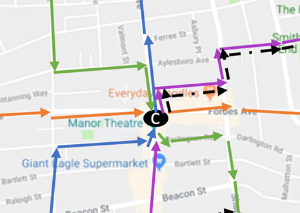Current Projects
Using Virtual Reality to Form Mental Maps
-
This NIH-supported study utilizes a virtual environment formed using Google StreetView data. Participants "walk" through the virtual environment and learn a series of intersecting routes. Two alternative methods of study are used, each "targeting" a different areas of the brain that store spatial information. This study hopes to advance our understanding of how mental maps and spatial memories develop over time, with potential application to older adults in subsequent research.
Spatial Reconstruction in Virtual Reality
-
In this experiment, participants will experience a series of virtual rooms through an immersive virtual reality headset (i.e., an Oculus rift). With an Oculus Rift headset on and a 360 degree photo loaded, participants will feel like they are standing in a scene somewhere and have the ability to look freely in all directions around them. This experiment consists of a series of trials aimed to test participants' abilities to quickly learn new scenes and determine their relative orientation in those scenes. The goal is to better understand how scenes are reconstructed in the mind's eye during memory retrieval.
The Dynamics of Forgetting for Recollected and Familiar Memories
-
Memories can be divided into two types. Recollection refers to the ability to mentally reconstruct the past and re-experience it in your mind's eye. Familiarity refers to a sense of knowing or acquaintance. In an ongoing series of experiments, we are investigating the long-term properties of these two kinds of memories, and specifically examining forgetting. Some of recent work suggests that recollected memories may be more resistant to interference than familiarity-based memories, and recollected memories may benefit from reminders or be less sensitive to semantic coherence.
The Impact of Active Encodings – The Production Effect
-
A simple yet reliable way to enhance memorability is to actively engage with the materials you're trying to encode. One specific instance of this is the production effect--the finding that reading some words aloud and others silently leads to better memory for the words read aloud. We are investigating a number of characteristics of this effect, including how exactly production changes memory, why it seems to be so dominant when compared to other, seemingly comparable active encodings, where it can override poor attentional states at encoding, and how the clarity of production influences subsequent memory. Throughout all these studies, a common conclusion we have drawn is that production is a remarkably simple yet remarkably effective means of encoding verbal information.



